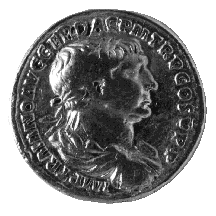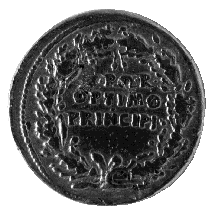



(90) Trajan - AV aureus, A.D. 103-111, 7.06 g. (inv. 91.158).
Obverse: Draped, cuirassed, and laureate bust of Trajan r.; IMP(ERATORI)
TRAIANO AVG(VSTO) GER(MANICO) DAC(ICO) P(ONTIFICI) M(AXIMO) TR(IBVNICIA)
P(OTESTATE) CO(N)S(VLI) V P(ATRI) P(ATRIAE): To Imperator Trajan Augustus,
conqueror of the Germans, conqueror of the Dacians, pontifex maximus,
with tribunician power, consul for the fifth time, father of the
country.
Reverse: Within oak wreath, S(ENATVS) P(OPVLVS)Q(VE) R(OMANVS) OPTIMO PRINCIPI:
the Senate and People of Rome, to the best princeps.
Provenance: L.S. Werner, 1959.
Bibliography: H. Mattingly and E.A. Sydenham, The Roman Imperial Coinage
II: Vespasian to Hadrian (London 1926) 150.
Under the emperor Trajan (Marcus Ulpius Traianus), who was first and foremost
a military ruler, the Roman empire reached its greatest territorial extent.
For his conquests of the Germans, Dacians, and Parthians he was awarded
the titles Germanicus, Dacicus, and Parthicus, but like Augustus he preferred
the more modest title princeps or leader. Also like Augustus, whom
he emulated in many respects, he was respected by the Senate. Although he
spent much of his time in the field with his troops, Trajan sponsored major
buildings and public works, both in Rome and in the provinces. He celebrated
his victories with lavish donations to the people and public entertainments,
and like Nerva he showed concern for the conditions of the poor. He died
returning from action in the East in A.D. 117 and was immediately deified.
The most significant aspect of Trajan's portrait is his hairstyle, with
its curved locks over the forehead, a deliberate imitation of the hair of
Augustus (see no. 65). In depicting himself this way, Trajan dissociated
himself from the Flavians and recalled a period of expansion and stability
in the empire. Although Trajan's portraits do not depict him as eternally
youthful in the manner of Augustus, he is nevertheless idealized to the
extent that he ages very little.
The reverse of this coin depicts the oak wreath, the corona civica
or civic crown that the Senate awarded him in A.D. 98 and that is another
allusion to Augustus, who had been awarded it by the Senate in 27 B.C. (see
no. 65). Within it is a dedication to the optimus princeps, the best
princeps, an honorary title awarded Trajan by the Senate.
K.S.



All contents copyright (c) 1996.
Lawrence University
All rights reserved.